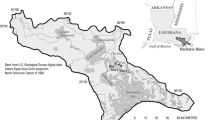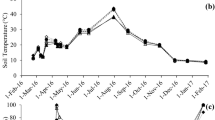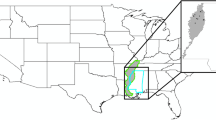Abstract
In restored salt marshes, seedling recruitment can be limited where large areas of soil are exposed and physical conditions are harsh. On a 0.7-ha excavated marsh plain, we studied recruitment as a function of abiotic (elevation) and biotic factors in 2 × 2 m plots planted with 0, 1, 3, or 6 species from the pool of 8 native halophytes. The random draws of 3-species and 6-species assemblages produced approximately equal numbers of plants per species for the experiment as a whole, yet only three species recruited> 10 seedlings per plot.Salicornia virginica andSalicornia bigelovii each produced> 15,000 seedlings in 1998, andSuaeda esteroa produced> 2,500 seedlings in 1999. For these 3 species, seedling recruitment increased with elevation in 1998, but this trend weakened in 1999, when species richness affected recruitment (fewer seedlings in more species-rich plots). Abiotic effects preceded biotic interactions in determining seedling recruitment patterns early in the development of the salt marsh. Effects of species richness appeared to be scale-dependent in that having all species present in the site likely enhanced overall recruitment (all species had 2 or more seedlings), while plantings of 6 species in a 2 × 2 m plot reduced seedling density.S. virginica was the only species that increased its presence and relative cover in the experimental site over the 4-yr study. Protocols for planting southern California salt marsh restoration sites could omit this species, but all others probably need to be introduced to restore diverse vegetation.
Similar content being viewed by others
Literature Cited
Adam, P. 1981. The vegetation of British salt marshes.New Phytologist 88:143–196.
Adam, P. 1990. Saltmarsh Ecology. Cambridge University Press, New York.
Adams, D. A. 1963. Factors influencing vascular plant zonation in North Carolina salt marshes.Ecology 44:445–456.
Bakker, J. P. andY. DeVries. 1992. Germination and early establishment of lower salt-marsh species in grazed and mown salt-marsh.Journal of Vegetation Science 3:247–252.
Baldwin, A. H. andI. A. Mendelssohn. 1998. Response of two oligohaline marsh communities to lethal and nonlethal disturbances.Oecologia 116:543–555.
Beeftink, W. G. 1985. Population dynamics of annualSalicornia species in the tidal salt of the Oosterschelde, The Netherlands.Vegetatio 61:127–136.
Bendix, J. andC. R. Hupp. 2000. Hydrological and geomorphological impacts on riparian plant communities.Hydrological Processes 14:2977–2990.
Bertness, M. D. andR. Callaway. 1994. Positive interactions in communities.Trends in Ecology and Evolution 9:191–193.
Bertness, M. D. andS. M. Yeh. 1994. Cooperative and competitive interactions in the recruitment of marsh elders.Ecology 1994:2416–2429.
Brewer, J. S., J. M. Levine, andM. D. Bertness. 1997. Effects of biomass removal and elevation on species richness in a New England salt marsh.Oikos 80:333–341.
Craft, C., J. Reader, J. N. Sacco, andS. W. Broome. 1999. Twenty-five years of ecosystem development of constructedSpartina alternifolia (Loisel) marshes.Ecological Applications 9:1405–1419.
Earle, J. C. andK. A. Kershaw. 1989. Vegetation patterns in James Bay coastal marshes. III. Salinity and elevation as factors influencing plant zonation.Canadian Journal of Botany 67:2967–2974.
Elton, C. S. 1958. The Ecology of Invasions by Animals and Plants. Methuen, London, U.K.
Ewel, J. J., M. J. Mazzarino, andC. W. Berish. 1991. Tropical soil fertility changes under monocultures and successional communities of different structure.Ecological Applications 1:289–302.
Hacker, S. D. andM. D. Bertness. 1999. Experimental evidence for factors maintaining plant species diversity in a New England salt marsh.Ecology 80:2064–2073.
Haltiner, J., J. B. Zedler, K. E. Boyer, G. D. Williams, andJ. C. Callaway. 1997. Influence of physical processes on the design, functioning and evolution of restored tidal wetlands in California (USA).Wetlands Ecology and Management 4:73–91.
Harley, C. D. G. andM. D. Bertness. 1996. Structural inter-dependence: An ecological consequence of morphological responses to crowding in marsh plants.Functional Ecology 10:654–661.
Hinde, H. P. 1954. The vertical distribution of salt marsh phanerogams in relation to tide levels.Ecological Monographs 24:209–225.
Hooper, D. U. andP. M. Vitousek. 1997. The effects of plant composition and diversity on ecosystem processes.Science 277:1302–1305.
Huiskes, A. H. L., B. P. Koutstaal, P. M. J. Herman, W. G. Beeftink, M. M. Markusse, andW. de Munck. 1995. Seed dispersal of halophytes in tidal salt marshes.Journal of Ecology 83:559–567.
Hutchings, M. J. andP. J. Russel. 1989. The seed regeneration dynamics of an emergent salt marsh.Journal of Ecology 77:615–637.
Ibarra-Obando, S. andM. Poumian-Tapia. 1992. The salt marsh vegetation of Punta Banda estuary, Baja California, Mexico, p. 201–211.In U. Seeliger (ed.), Coastal Plant Communities of Latin America. Academic Press, San Diego, California.
Jefferies, R. L., A. J. Davy, andT. Rudmik. 1981. Population biology of the salt marsh annualSalicornia europea Agg.Journal of Ecology 69:17–31.
Keer, G. andJ. B. Zedler. 2002. Salt marsh canopy architecture differs with the number and composition of species.Ecological Applications 12:456–473.
Khan, M. A. andI. A. Ungar. 1984. Seed polymorphism and germination responses to salinity stress inAtriplex triangularis Willd.Botanical Gazette 145:487–494.
Kramer, C. Y. 1956. Extension of multiple range tests to group means with unequal number of replications.Biometrics 12:309–310.
Langis, R., M. Zalejko, andJ. B. Zedler. 1991. Nitrogen assessments in a constructed and a natural salt marsh of San Diego Bay.Ecological Applications 1:40–51.
Lertzman, K. P. 1995. Forest dynamics, differential mortality and variable recruitment probabilities.Journal of Vegetation Science 6:191–204.
Lindig-Cisneros R. andJ. B. Zedler. 2000. Restoring urban habitats: A comparative study.Ecological Restoration 18:184–192.
Martens, S. N., D. D. Breshears, andC. W. Meyer. 2000. Spatial distribution of understory light along the grassland/forest continuum: Effects of cover, height, and spatial pattern of tree canopies.Ecological Modeling 126:79–93.
Miller, W. R. andF. E. Egler. 1950. Vegetation of the Wequetequock-Pawcatuck tidal-marshes, Connecticut.Ecological Monographs 20:143–172.
Naeem, S., J. H. M. Knops, D. Tilman, K. M. Howe, T. Kennedy, andS. Gale. 2000. Plant diversity increases resistance to invasion in the absence of covarying extrinsic factors.Oikos 91:97–108.
Naeem, S., K. Hakansson, J. H. Lawton, M. J. Crawley, andL. J. Thompson. 1996. Biodiversity and plant productivity in a model assemblage of plant species.Oikos 76:259–264.
Noe, G. B. andJ. B. Zedler. 2000. Differential effects of four abiotic factors on the germination of salt marsh annuals.American Journal of Botany 87:1679–1692.
Palmer, M. A., R. F. Ambrose, andN. L. Poff. 1997. Ecological theory and community restoration ecology.Restoration Ecology 5:291–300.
Rejmanek, M. 1989. Invasibility of plant communities, p. 369–388.In J. A. Drake, H. A. Mooney, F. di Castri, R. H. Groves, F. J. Kruger, M. Rejmanek, and M. Williamson (eds.), Biological Invasions: A Global Perspective. John Wiley and Sons, London, U.K.
Sanchez, J. M., J. Izco, andM. Medrano. 1996. Relationships between vegetation zonation and altitude in a salt-marsh system in northwest Spain.Journal of Vegetation Science 7:605–702.
Sequeira, W. andH. L. Gholz. 1991. Canopy structure, light penetration and tree growth in a slash pine (Pinus elliotti) silvo-pastoril system at different stand configurations in Florida.Forest Chronicle 67:262–267.
Skalova, H., F. Krahulec, H. J. During, V. Hadincova, S. Pechackova, andT. Herben. 1999. Grassland canopy composition and spatial heterogeneity in the light quality.Plant Ecology 143:129–139.
Sullivan, G. 2001. Establishing vegetation in restored and created coastal wetlands, p. 119–155.In J. Zedler (ed.), Handbook for Restoring Tidal Wetlands. CRC Press, Boca Raton, Florida.
Tessier, M., J. C. Gloaguen, andJ. C. Lefeuvre. 2000. Factors affecting the population dynamics ofSuaeda maritima at initial stages of development.Plant Ecology 147:193–203.
Tilman, D. 1997. Community invasibility, recruitment limitation, and grassland biodiversity.Ecology 78:81–92.
Tilman, D., J. Knops, D. Wedin, P. Reich, M. Ritchie, andE. Siemann. 1997. The influence of functional diversity and composition on ecosystem processes.Science 277:1300–1302.
Tilman, D., D. Wedin, andJ. Knops. 1996. Productivity and sustainability influenced by biodiversity in grassland ecosystems.Nature 379:718–720.
Torstensson, P. 1987. The demography of the annualSpargularia marina on a Baltic seashore meadow.Vegetatio 68:157–168.
Trenbath, B. R. 1974. Biomass productivity of mixtures.Advances in Agronomy 26:177–210.
Ungar, I. A. 1987. Population ecology of halophyte seeds.The Botanical Review 53:301–334.
Ungar, I. A. 1995. Seed germination and seed-bank ecology in halophytes, p. 599–628.In J. Kigel and G. Galili (eds.). Seed Development and Germination. Marcel Dekker, New York.
Ungar, I. A. 1998. Are biotic factors significant in influencing the distribution of halophytes in saline habitats?Botanical Review 64:176–199.
van der Wal, R., M. Egas, A. van der Veen, andJ. Bakker. 2000. Effects of resource competition and herbivory on plant performance along natural productivity gradients.Journal of Ecology 88:317–330.
Vince, S. W. andA. A. Snow. 1984. Plant zonation in an Alaskan salt marsh. I. Distribution, abundance and environmental factors.Journal of Ecology 72:651–657.
Vivian-Smith, G. 1997. Microtopographic heterogeneity and floristic diversity in experimental wetland communities.Journal of Ecology 85:71–82.
Vogl, R. J. 1966. Salt-marsh vegetation of upper Newport Bay, California.Ecology 47:80–87.
Warren Wilson, J. 1963. Estimation of foliage denseness and foliage angle by inclined point quadrats.Australian Journal of Botany 11:95–105.
Wiegand, T. andS. J. Milton. 1996. Vegetation change in semiarid communities: Simulating probabilities and time scales.Vegetatio 125:169–183.
Zedler, J. B. 1977. Salt marsh community structure in the Tijuana estuary, California.Estuarine, Coastal and Marine Science 5:39–53.
Zedler, J. B. (ed.). 2001. Handbook for Restoring Tidal Wetlands. Marine Science Series, CRC Press LLC, Boca Raton, Florida.
Zedler, J. B. andG. W. Cox. 1984. Characterizing wetland boundaries: A Pacific coast example.Wetlands 4:43–55.
Author information
Authors and Affiliations
Corresponding author
Rights and permissions
About this article
Cite this article
Lindig-Cisneros, R., Zedler, J.B. Halophyte recruitment in a salt marsh restoration site. Estuaries 25, 1174–1183 (2002). https://doi.org/10.1007/BF02692214
Received:
Accepted:
Issue Date:
DOI: https://doi.org/10.1007/BF02692214




